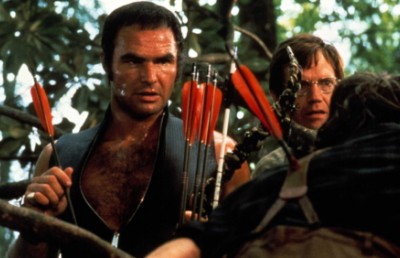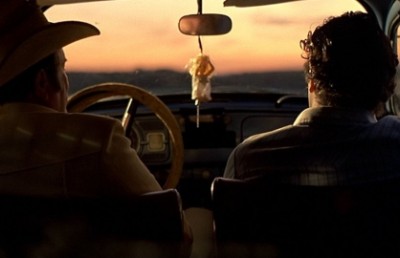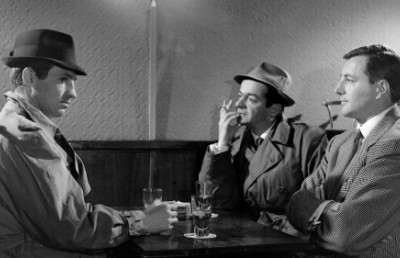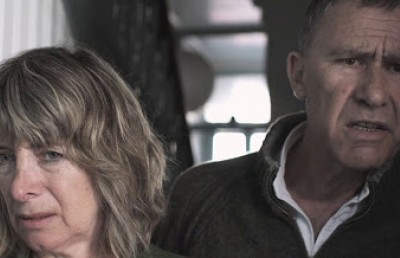Charles Laughton’s Uniquely Noir Night of the Hunter (1955)
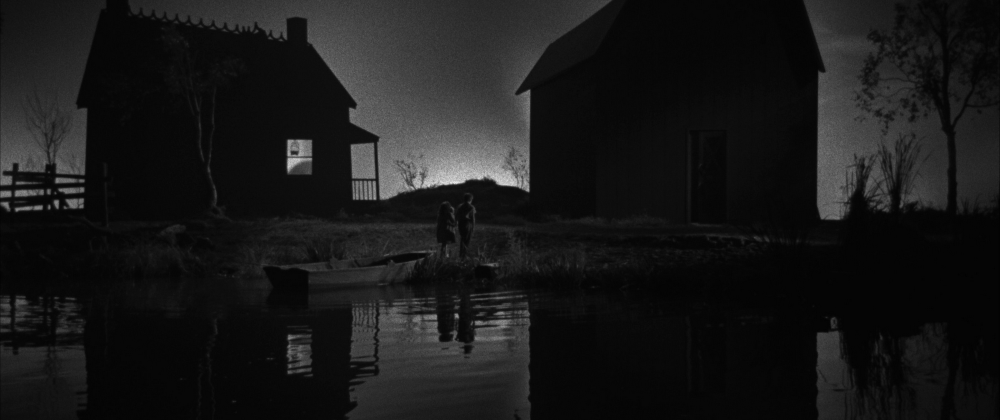
Where do murderers go, man! Who’s to doom when the judge himself is dragged to the bar? – Herman Melville’s Moby Dick (epigraph in The Night of the Hunter novel).
Night of the Hunter is based on the 1953 novel by Davis Grubb. In 1954, it was allegedly transformed into a screenplay by James Agee and subsequently made into a film by independent producer Paul Gregory, being released through United Artists in 1955. The famous British actor, Charles Laughton, directed this unique, paradoxical film noir, guiding the performances of star players such as Robert Mitchum, Shelley Winters, and Lillian Gish. This film is characterized by a slew of meaningful narrative dialogue, approaching the fidelity of the original tale; and dispersed through it, the singing of a leitmotif religious hymn. Its mise-en-scene sets up the denouement of a intricate plot and terrifying fairy tale story suffused with poetic American melodrama.
A formal approach to analyze Night of the Hunter is to select the narrative construction as the point of attack because the film closely mirrors the novel and its dialogue. Supporting the narrative approach, mise-en-scene and sound will be used to flank the film analysis because of the arcanian expressionism of its photographic images and the haunting allure of its music and thematic hymn.
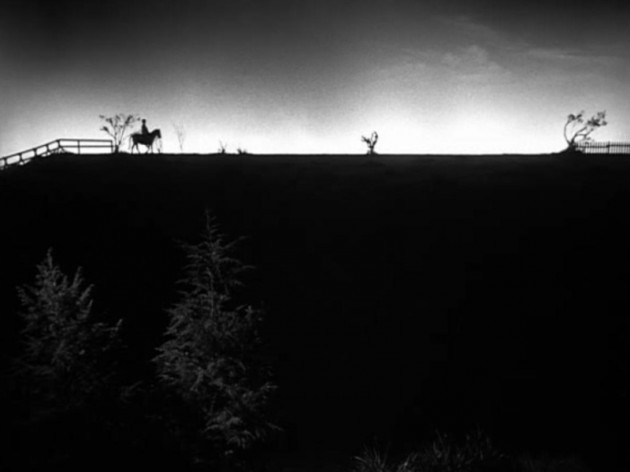
As a whole Night of the Hunter is a mise-en-scene imbued with a complex narrative and moreover, it is finessed with an esoteric musical score. It creates formal expectations through modified conventional film practices and knowledge of American social histories. It is simultaneously terrifying and comical, with a deep seated emotional impact, making it soar in the realms of ironic black humor. There is no question that it is a disturbing work of art, making it unappreciated in its time because it caused serious censorship problems all over the world (Turner 1340).
But above all, The Night of the Hunter veils layers of affective meaning which stirs emotions not only in the audience of the McCarthy period (i.e. McCarthyism’s “Second Red Scare,” lasting roughly from 1947 to 1956) but also those of our own lives of today; indeed, this fact makes it a perpetual masterpiece of filmic art. This nesting of affective meaning combines with a strikingly effective emotional punch which awakens deep feelings within the spectator; moreover, this amalgamation causes recoil reactions from the institutions that produced it. In Night of the Hunter, this affective meaning is a mix of textual cues (in this case dialogue, composition and sound), creating an interplay of ideas and emotions flowing between the viewer and the filmmaker. This fluidic interplay is crucial for the film to work.
Interestingly, this interactive cinema between spectator and filmmaker, one which occurs in Night of the Hunter, manifests itself at different levels of cinematic meaning and in different realms of the human psyche. Formally, its referential meaning plots out the story in 1930, specifically, in the Ohio River Valley country of West Virginia, at a place called Cresap’s Landing, and importantly at the beginning of the American economic Depression (Grubb 3). It narrates the tale of a psychopathic killer who poses as a preacher, and whom subsequently marries and murders a tragic, naively loving widow and mother, for the sake of pursuing her two children for the money hidden in the little girl’s doll. The children meet up with an old, strong-minded woman who takes in unwanted kids, raising them as her own. The crazed maniac catches up with the fleeing children at the kind Samaritan’s house, where the straight-willed lady shoots him for threatening the kids; and thereupon the police arrests him for the butchery of the mother. It all ends at Christmas, an apparently happy ending for a classically conventional film; but that conclusion is far from the truth.
Night of the Hunter is a complex story with hidden meaning and strong spiritual overtones. Moreover, the film goes beyond mere treatment of ethical morality as it penetrates the realms of psycho-sociological considerations. The movie’s explicit meaning is about good versus evil, love versus hate, innocence versus experience, and dream versus reality. It begins in an unconventional manner with an establishing shot of an abstract, celestial star background, as if it was a dream, and continues as an oneiric forewarning about the amorality of some human beings that lurk among us. Juxtaposed to the imagery is a gruesome, full orchestration of engulfing horns, shocking violins and shattering timbals, whose eerie composition (staccato) will later come to signify the evil intent of Harry Powell (Robert Mitchum), a fake, blood thirsty evangelist, an anomie dressed like Abraham Lincoln. Before words are spoken, the music shifts to heavenly harps and soothing string arrangements as it combines with a gentle, mixed chorus singing: “Dream Little One Dream … Fear is Only a Dream.” So as the audio-visuals are introduced, then comes the characters; first, the five orphan children set in a half-moon composition, again signifying the heavenly dream. Next comes Rachel Cooper (Lillian Gish), the film’s narrator, an incarnate spiritual being whose prophetic words are juxtaposed with intercuts of swooping helicopter shots of pastoral settings and starlit sky, an ominous sermon which resounds throughout the film: “Beware of false prophets which come to you in sheep’s clothing but inwardly they are ravening wolves. Ye shall know them by their fruits. A good tree cannot bring forth evil fruit, neither can a corrupt tree bring forth good fruit. Wherefore by their fruits ye shall know them (Agee 263). Finally, the film reintroduces the serial killer, now visually, talking to himself, driving along a river landscape in a open touring automobile. The significance of the opening is central to the rest of the narrative.
There are many early scenes in this movie that must be skipped over, such as the discovery of the woman’s body inside the entrance of the storm cellar and the Preacher’s libidinous visit to the strip joint; but before proceeding with the principal roles of the children, an immensely ubiquitous passage exits in Night of the Hunter, an ubiquity in time reflecting the prophetic art of story telling. The existence of this piece of dialogue is a foreboding preamble to present events in the world today. Recall the scene at the burlesque house when the Preacher 1 says: “No, there are too many of them; you can’t kill a world” (Agee 265). This film takes on abysmal psychic overtones that transcend literary space and real time, prognosticating the coming of an evil, world threatening disease (remember the Armageddon wish of Osama Bin Laden’s Al-Qaeda). It wasn’t James Agee who wrote this screenplay (the public was mislead); indeed, Davis Grubb, with incredible foresight, wrote the script and that is why it is so very close to the novel (Hammond 106). The point to be made here is more than just the ravages of evil doers, for Grubb is writing in terms of the “End of the World,” that is, practically speaking, the extinction of the human species. Remember that even though the Neanderthals survived 250,000 years, they too became extinct.
Aside from the initial abstraction of the children posing for the gaze of the audience, the narrative introduces and concentrates on the children protagonists, stalwart John Harper (Billy Chapin) and innocent Pearl Harper (Sally Jane Bruce), including an inanimate child doll named Miss Jenny, all of whom propel the amazing story forward. Moreover, the children form, to a large extent, the conceptual structure for the implicit meaning of the film; indeed, this last statement is nothing less than a very broad interpretation that borders the realm of the unconscious, as it deals with the narrative’s psycho-sociological implications of the alienation of the sexes and of the nuclear family breakdown. The film’s implicit meaning is about the functional makeup of the American social subconscious, especially the dysfunctional family units sprawled across the Ohio River country during the period of the Depression. The movie involves the allegorical creation of the anodyne fantasies of the children, which is supposed to guard them against the mental and sometimes physical abuse suffered at the hands of the parents (the metaphor of the hand, or of the touching hand, plays a dominant role in this fantastic film). In essence, the child becomes a neurotic while in constant psychic combat and sexual rivalry with the parent folks, suffering from paranoiac delusions he or she creates a new world with new relations (for example, Miss Jenny). In an article, Paul Hammond coins the term ‘family romance’ and goes on to say: “Gripped by Oedipal fear, the child feels slighted and so imagines a more ideal family for himself” (Hammond 107). Note that for a female child this neurotic fear is based on the Electra complex.
Night of the Hunter is a complex film because it incorporates allegorical recounting within its narrative structure, doing so through the dream motif, a recurrent element throughout the story; and indeed, it can be viewed as a sequence of foreboding nightmares. Recall that Ben Harper (Peter Graves) speaks within a dream, divulging the existence of the money to the Reverend. Here, in this movie, the act of storytelling is multifunctional in allowing the children to escape into phantasm, a refuge protecting them from the dread of the real world; and it is also one which serves to inform the audience of the diegetic denouement, giving them insight and unrestricted knowledge.
Truly, Laughton’s film is a set of allegorical tales; indeed, the first one is sung by the children in the playground after the hanging of Ben Harper: “… see what the Hangman done! Hung, hang, hing! See the Robber swing! Hing, hang, hung! Now my song is done!” (Agee 273). The next tale is told to Pearl by John in the bedroom scene: “Tell me a story, John” (Agee 276). So as soft violins and gentle horns play, John recounts the time of a wealthy king of Africa (Ben Harper) who is kidnapped by evil doers and whom tells his son to protect his gold ($10k). Now recall if you can, just before this scene, the establishing and eerie composition with full orchestration juxtaposed with two ominous long shots of a big black train, which is apparently heading for Cresap’s Landing; and as John reaches halfway through telling his story, his act of recounting the tale is halted by the same eerie music combined with the overlap of the Preacher’s shadow onto that of John’s, as Powell stands outside in their front yard, just below the street lamp. It is as though the train had delivered this monster right on their front steps. Moreover, the position of the lamp is incongruous in casting such a shadow onto the kids’ bedroom window, a powerful indicator of the emission of anti-light by an evil spirit. Many interrelated stories are told in Night of the Hunter, motivating this allegorical narrative – here are some examples, starting with Harry Powell’s pawing depiction of the eternal battle between good (love) and evil (hate), Pearl’s river song about the fly family (a musical theme in the film), and of Rachel Cooper’s story about Moses and Herod’s vendetta against Jesus; and even Uncle Birdie Steptoe (James Gleason), whom has never hurt a fly, sings his own story while playing his guitar outside the front door of his river shack: “ ‘Twas down at Cresap’s Landing, along the River Shore, Birdie Steptoe was a Pilot in the good old days of yore. Now he sets in his old wharf-boat … So the big boats heave a sigh, they blow for Uncle Birdie … And the times that are gone by.”
The music supervisor, Walter Schumann [1913-1958], characterized the score in three ways. First, six autonomous segments acting both as continuous accompaniment as well as punctual interventions, ran for the first quarter hour. A half hour into the film, a long, musical flow develops for more than eighteen minutes, only cut by three rests totaling barely twenty seconds. Second, the rigorous usage of singing voices justified by the fiction which identifies their sources, and the orchestral commentary which takes charge of the leitmotifs, taking over from the conventional accompaniment. Third, the essential organization of the music based on six themes, expressively varied as less mixed and mostly alternating leitmotifs, structuring a framework for a critical evaluation. Of these six leitmotifs, three are attached to the characters (Powell, Willa, and Rachel) and three have dramatic situation values (the pursuit, the lullaby, and leaving home).
The pursuit is a series of violent violin strokes and colliding motifs which are more movement than melodies. This frantic staccato bursts into Powell’s pursuit of the children from the house to the river, and had been announced in the first few seconds of the credits. It would develop a third time in the epilogue, when the children would have to flee the town away from the lynch mob.
The dream lullaby succeeds the pursuit leitmotif and serves as the sound decor for the first appearance of Rachel onto a starlit background. It is sung by children voices and it will not be heard again until a hour later when, on a halt down river, the two orphans stop to listen to an invisible mother cradling her infant, just before they go to sleep in a hayloft. The lullaby is a theme of the home and it is reinforced by the reappearance of Rachel; moreover, it would appear at least seven times in distinct discourses in the last twenty five minutes of the film. Even though it is linked to Rachel, it is an expression of maternal instinct because it is convoked for a waitress who rushes out of her shop to hug Mary, the smallest of the orphans. The lullaby concludes the film as it introduced it.
The theme of leaving home knows its development during the downstream journey which lasts about ten minutes. It is identified with Pearl’s river song, but it was announced earlier with the appearance of the kids in the prairie before the arrival of their father. It is the leitmotif which accompanies the story told by John to Pearl in the bedroom the night of the arrival of Powell. It has been commented on (diegetically, so to speak) within the film’s musical score by mixing it with the staccato of the pursuit during their expulsion from the home; moreover, only after Rachel discovers John and Pearl does it reappear, but only two more times near the end of the movie: 1) when John chooses the apple he wants to give Rachel and, 2) when Rachel makes a remark to John about how it reassures her in hearing inside the house the tic-tac of his new watch (a Christmas gift). And what seems now to murmur the theme of separation (associated with leaving home) becomes a new theme which, in diasporadical manner, reconstitutes the lost unity after the pain of dispersion.
Besides storytelling, Night of the Hunter is dominated with motivating music and sound-over which can be considered on an equal footing with the mise-en-scene. The film is an intricate weave of visual styles cued to deliberate and significant musical compositions with esoteric overtones. As mentioned above, Harry Powell is cued throughout it by a chilling and eerie orchestral composition, a frantic staccato; however, it is not the only musical thematic ideation in the movie. In fact, one of its subtler mellifluous muses is associated with Willa Harper’s (Shelley Winters) martyrdom; indeed, this sad music is a waltz (i.e. ‘une valse triste’) which is introduced in the scene where Willa walks off into the fog, like a ghost, as she leaves the Spoon’s Ice Cream Palor to return home. It is an arrangement by the Finnish composer Jean Julius Christian Sibelius [1865 – 1957], called ‘Valse Triste,’ and was emphatically inserted into Willa’s two death scenes by the director of cinematography, Stanley Cortez, in order to magnify the impact of the lighting, set design and acting (Turner 1337). As Turner explains about Cortez’s motivation: “Composed by Sibelius, it was part of a saga and told of a scene that takes place in a graveyard at one minute past midnight. Bones come to life and do a dance in sheer mockery of life, which was the exact thing Mitchum was doing because of the love and hate thing” (Turner 1338). The emotional thrust of ‘Valse Triste’ is oneirically herculean when combined with the eerie undulation of the corpse’s hair and the wavy sway of the river’s meadow grass, as its affect on the audience is stunningly hypnotizing. Moreover, this melancholic waltz is not only an irony about life and death, but it is also part of a structure that forms the basis for the symptomatic meaning of Night of the Hunter.
But what is interesting about this film are the ways in which it defines itself, stitching the motif of the dream, the theme of storytelling, and of the soundtrack, into the form of a living doll, that is, the silent and enigmatic character of Miss Jenny (in effect, a surrogate ‘Pearl’); but importantly, it also manipulates the audience to the point of delusion, as though it was a marionette. Pearl and the doll never depart, except at the end when it comes crashing down, like a lightning bolt from heaven, onto the back of the Preacher, its belly ripping open with oozing gilt. If John conjures up dreams, then Pearl is in fact the wishful dream, the unconscious muse, the Oedipal conundrum and riddle of the Sphinx. She is the embodiment of one of the greatest ironies of them all —that of a small child feeling unconditional love for a great evil— truly, she is the love that abides and endures in us all.
Night of the Hunter may be dominated by the active character of John; but ironically, this story is underscored and driven by the passiveness of Pearl. She is an emblematic contradiction, breathing life into a doll and an idea into a story. Her character exists simultaneously in two forms, the daughter of the Immaculate Conception (Virgin Mary) and the mother’s desired body (Willa/Eve/Apple). Pearl is the quintessential idea that enters into the fourth dimension of meaning, the symptomatic form; ideologically, she simulates the dramatic irony and stylistic conflict that exist in filmmaking. She represents the eclectic Brechtian expressionism (a flatten out rag doll with diamond shaped check bones and buttons for eyes) that smooths out the jagged depths in the Griffithian pastoral compositions. She is the grand incarnation of cinematic excellence, always quietly existing within the frame (when present), sometimes silent and at other times not, never complaining as she follows, like history through time; indeed, she is the ultimate reason for cinema to exist. She is the Apple of our Tree of Life (both primordial sin and fertility at the same time, cinematically speaking).
Night of the Hunter is a filmmaker’s musical dream in which a triptych duel of song and hymn unfolds amidst a complex narrative, conflicting styles and mixed aesthetics. Recall the scene in the jail cell at the Moundsville, West Virginia, high security penitentiary, when the Preacher tells Ben Harper: “I come not with Peace but with a Sword” (Agee 270). And Agee (actually Grubb) writes further on: “He (Ben) wads the sock into his mouth and lies back, sardonic” (Agee 271). Harry Powell’s sword is not his phallic switchblade but his silver tongue, a dramatic motif used to cut down and subdue; indeed, it is also a cinematic motivation sexualizing the existence of his character, just as the right hand of love is used to masturbate. His devilish tongue is used to sing the Protestant hymn ‘Leaning on the Everlasting Arms’ a leitmotif used throughout the film, expressing his hypocritical and repressive Revivalism. It is not a true leitmotif because it does not involve orchestral variations; but nevertheless, it expresses part of Powell’s personage in the motif of the funeral, while the other part (the menacing incarnation of the psychopathic killer) is suggested in the introductory staccato. The hymn is audibly expressionistic, rendered in ‘a cappella’style (except for its third occurrence), and it comes into play four times in the film and always in the same circumstance — sung peacefully in the shadows, exterior to a flatten out compositions of some building, menacing public safety. The preacher sings it for the first time upon his appearance at the Harper house, under the children’s bedroom window, as Pearl says: “’’Night Miss Jenny; don’t let the bedbugs bite,” the Reverend begins singing: “Leaning Leaning Safe and Secure from All Alarm, Leaning Leaning Leaning on the Everlasting Arms, What a Fellowship What Peace is Mine Leaning on the Everlasting Arms, What Blessedness What Joy Divine Leaning on the Everlasting” (Agee 277). When this hymn is linked with Powell’s little story of ‘Right-Hand-Left-Hand,’ the tale of Good and Evil, a puppet show (the metaphor of the ‘touch’) is made to appear; and at the end of the film, the difference between right and wrong is almost evanescent as it is sung again in counterpoint by the Preacher and Rachel, the latter of whom adds only one extra word to her chorus – ‘Jesus.’
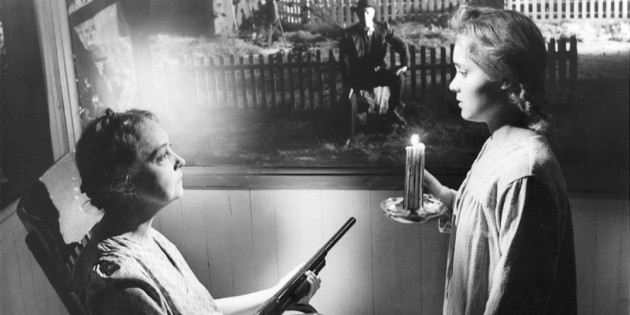
Besides the singing of ‘Hing, hang, hung!’ by the children at the Schoolhouse and ‘Brighten the Corner/Bringin’ in the Sheaves’ at the pick-nick, the vocals are carried by the Reverend, Pearl and Rachel. Pearl sings only once, after the escape down river, from the pursuit of the monstrous Reverend, “Big Bad Wolf” in the script (Agee 316). In a camera long shot, the river, the landscape and the stars create a setting for a truly oneiric moment, wherein, we see John sleeping at the bow of the skiff when Pearl, caressing Miss Jenny’s hair, sings her river song (a ‘family romance,’ a major compositional development and turning point in the film): “Once upon a time there was a pretty fly, he had a pretty wife this pretty fly; but one day she flew away, flew away. She had two pretty children, but one night these two pretty children flew away, flew away into the sky, into the moon” (Agee 320). The metaphor of the ‘moon’ appears in her romance, the dreamscape of many nocturnal wanderers, including the symbolic animals (expressing vulnerability and predation) that roam the night and early morning (frog, owl, turtle, rabbit, sheep, cow, whippoorwill, dog, fox, and roaster). But there was also a cobweb, the deadly trap that lay invisible, with the spider concealed, waiting to snag the pretty fly. The Oedipal fears of these children are so tremendous that they create self made pitfalls, latently hidden in the depths of their subconscious, ready at any moment to snare them into a feast for the beast. About halfway through the film, the children are mesmerized, as are the spectators, because they have all been set adrift in the surrealism of the story; indeed, the audience is experiencing the down stream flow of the skiff pass the riparian minds of Pearl and John, two lunarians.
Rachel Cooper is the last member of the euphonious triad to enter the thematic engagement raging through the concrete portion of Night of the Hunter; and without a doubt, she was the first to be directly introduced in its initial abstraction, even though she is never seen singing the introductory oneiric cradle song (referencing her cradle rocking in Griffith’s momumental Intolerance, 1916), the dream lullaby. Rachel is the dragon slayer and she is also the audience, as is Powell, because as Paul Hammond puts it: “Powell/Mitchum is in the audience, staring aggressively at a stripper going through the motions” (Hammond 107). Voyeurism is one of the links between the spectator and the film’s aesthetics; indeed, voyeuristic scopophilia begins in the ambiguous surreal zone of the human psyche [maybe heaven (if not hell) or consciousness (if not unconsciousness) itself]; but what is certain here, or at least clear, is that it deals with the child’s dream or nightmare, whichever applies best, by way of the fairy tale. The vocalist, accompanied with heavenly harps and smooth violins, begins singing, right after the introduction of the eerie orchestration, later to be identified with the hideous Preacher: “Dream Little One Dream … Fear is Only a Dream.”
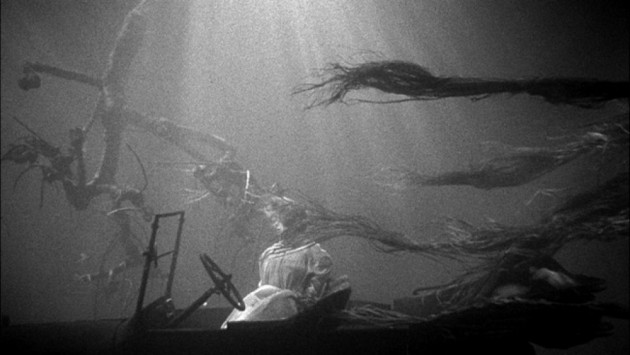
Night of the Hunter is a child’s most terrifying nightmare, a ‘cauchemar’ about being abducted by a serial killer, a monstrous ogre, and then being severely ravaged and savagely eaten to death (while still alive), and not only eaten but slowly devoured, piece by piece. The supportive evidence for this macabre feeling comes from two sequential scenes coming after the children, hiding from Powell, covered with coal-dust, come up from the cellar. Recall that the Protestant hymn ‘Leaning!’ has just reoccurred for the second time in a moving camera ‘underwater’ scene of Willa, serene in her death. First, Uncle Birdie, drunk in his rocking chair, says: “Down there in the deep place … her hair wavin’ lazy and soft like meadow grass under the flood waters and that slit in her throat just like she had an extra mouth. And there ain’t a mortal human I can tell but you (looking at the photograph of his dead wife)” (Hammond 311). Indeed, a man-eating monster, better still, a woman-eaten by a monster, transformed into a living dead with two mouths (referring to the vampiric myth of Dracula), would scare any child to death. Second, the next scene of the Reverend sitting at the head of the table, like a heinous ogre, with the kids standing around him, and as Agee (actually Davis Grubb) writes: “Pearl stands to John’s right, hugging (touch) the doll. The table is loaded with good food. Preacher, well-fed and at leisure, dabs his mouth delicately with his napkin, folds it, puts it in a ring, and folds his hands (the ‘touching’ hand). He waits” (Hammond 311). The writer is describing the habits of ravenous ogre, waiting to become hungry again; and this time, the good foods are the kids, especially little girls. The metaphor of the ‘touch’ is summoned up again: “Now watch and I’ll show you the Story of Life. The fingers of these hands, dear hearts! – They’re always a-tuggin’ and a-warrin’ one hand agin’ t’other. (he locks his fingers and writhes them, crackling the joints) Look at ‘em, dear hearts!” (Hammond 280). Incredibly haptic, this dining table scenario gives us an extended image of crushing bones splitting under the digital teeth of a ‘loup-garou’ ogre, nothing short than ‘one hand eating the other.’
The narrative closure of Night of the Hunter is apparently motivated through the character of Rachel but it is only another oneiric illusion, one of many wishful dreamscapes conveyed through the cinematic artistry of the film. Despite the Christmas scene at the end, it is a very open work of film art because, halfway through it, another oneiric cradle song is sung: “Hush little one hush. Hush my little one hush. Morning soon shall light your pillow. Birds will sing in yonder willow. Hush my little one hush. Hush my little one hush.” Before the last line of this first verse, Pearl asks John: “Are we goin’ home, John?” and John replies: “Ssh…” (Hammond 323). The implication of this onomatopoeia (i.e. “Ssh…”) is truly fascinating, to say the least, because now the storyteller is remaining silent since he too is but a dream-reverie. Yet, the hush lullaby is not yet over since there is a second verse: “Rest dearest one rest. Rest here on my breast. Little child with heart so brave. Angel holds will keep you safe. Rest my little one rest. Rest little one rest.” Interestingly, the leitmotifs leading the ‘berceuse’ movements of both these lullaby verses parallel each other; but here the hush lullaby is not a sleepy dream melody, for it is a somewhat foreboding song of prudence. The metaphor of the ‘moon’ links them (i.e. the two lullaby verses) into memory, as the whippoorwill echoes into the night and the children sleep in the hayloft; indeed, a phantasmal, light slivered, full moon rises up along the lunar ecliptic to a point in the upper right of the frame, and there appearing with it a bright star shines, it is the sign of ‘Jesus’. But the devil is lurking in this dream-reverie because John awakens to the sound of: “Leaning, Leaning; Leaning on the Everlasting Arms.” And as he watches in dread and despair, he says prophetically: “Don’t you never sleep?” (Hammond 324). Truly, it is enthralling that a double negative has been inserted or left inside this particular line of dialogue, for it implies that the devil always resides in our dreams; and in a bizarre cinematic way, this kind of scriptwriting points to the ‘stuff that dreams are made of’ because, at the end of the day, better still, at the end of the night —life is nothing but ‘Le Reve du Diable’. It is important to note here that it is the third occurrence of the hymn and moreover, it is mixed with an orchestral accompaniment associated with the children’s escape; but it is less an arrangement of hymn and pursuit than a true canticle dialogue with Powell’s own orchestral motif. Symptomatically, the most significant irony in Night of the Hunter, and perhaps in Christian repressive puritan ideology, is ‘La Danse avec le Diable’. In our case with the leitmotifs and musical arrangements of this film, the canticle duet in counterpoint between Rachel Cooper and Harry Powell is truly ironic. No doubt that it is a gripping and uplifting cinematic moment (it almost makes you cry, creating an ‘epiphora’); and when, figuratively speaking, God and Satan come together in the name of ‘Jesus’, as they (i.e. Cooper and Powell) perform their magical hymnody for the audience, this strikingly incongruous irony uplifts you to the heights of Heaven, at the same time, brings you close to the gates of Hell. Indeed, this incredible moment initiates the climax of the story and brings about the fourth and last time that the Protestant hymn is sung. And in an amazing ‘exterior-interior’ shot, one that is separated by a fine mesh screen (either that of a Catholic confessional or maybe even the cinema’s silver screen), a complex counterpoise composition is created. So as Armageddon nears, Rachel, gun in lap, rocking in her chair, hears the Preacher’s (the act of listening) a cappella; and with surgical precision, she naturally joins him in counterpoint, blending her voice with his, like two lovers becoming ‘One in Love.’ The only word ‘Jesus’ is added to the duet as if exorcising an evil spirit, as Rachel unveils Powell’s demonic intent by vocally denouncing his false anointment. It is here that ‘murderer becomes murderess’ (or at least the right to murder), in which the distinction between Good and Evil vanishes; and in a spiritual dialogue with Satan, sanctioned by an anonymous God, Rachel invokes the unseen power of Iesous, a throwback to the meaning of the citation in the prologue. For Jesus is the love that beatifies the pure of hearts, guarding them against false prophets, and forbids them to judge ye’ be judge themselves (recall John’s refusal to testify in the courtroom).
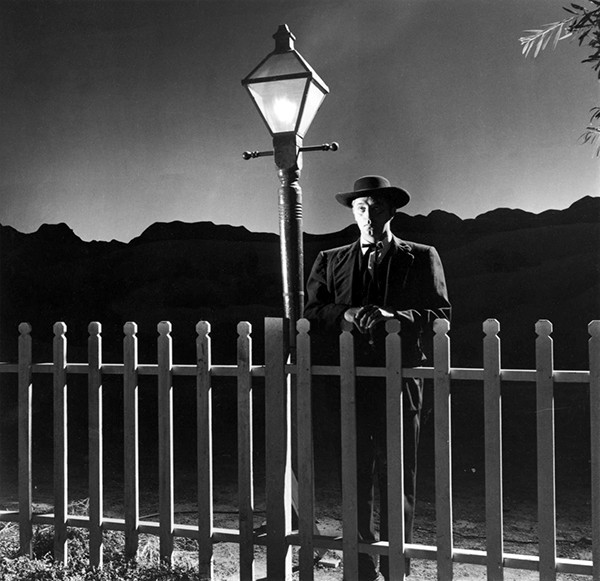
Lastly, the metaphor of the ‘touch’ is evocated in the hymn through the motif of the arms, either as hugging arms that surround the body or as armed hands that wrap around the throat to strangle (‘Right-Arm-Left-Arm,’ the tale of Good and Evil, the Strong and the Weak). Recall just before the hymn duet scene, the Preacher screams out: “The Lord God Jehovah will guide my hand in vengeance! You devils! You Whores of Babylon! I’ll come back when it’s dark!” (Hammond 340). Like a vampire, Powell’s spiritual strength and deceptive tactics come from the scarcity of light, and the lack of mental clarity from his victims. Recall that Powell’s shadow, projected autonomously without a proper light source, onto the screen of the boy’s bedroom wall, implies that he may not be able to cast a reflection in a mirror. Powell may be considered a living dead, a being without existence. Thus, Powell is like a Josef von Sternberg character (Lola Lola, for instance), he does not exist outside the frame of the image — this makes him ephemerally like a cartoon figure. The same argument applies to Rachel, she exists only in the starlit abstraction of our minds. Moreover, Powell’s appearance at the Harper house establishes the fantastic nature of filmmaking, creating a cinematic spectacle for the viewer’s perception, and in turn, programming the spectator for its reception. So cinema plays with itself in Night of the Hunter, for instance, film form becomes itself an irony: “As Powell leans over the prone Willa, the passage of his knife across her throat is symbolized by a vertical wipe to her cherubic children asleep next door” (Hammond 109). The mother’s dreaded dream become the children’s worse nightmare.
In the final analysis, the preacher and the old lady are two sides of the same coin, different polarities of the same force, totalitarian belief in the Good and totalitarian belief in the Bad. They are both spiritual absolutists, expressing their ideas and interpretations of religion at the exclusion of others. Rachel is honestly conceited and biased in her belief about the goodness of children and of being a strong tree with many birds; while Powell is a twisted, egotistical lunatic, a Baptist puritan equally biased in his hatred of woman: “But there are things you do hate, Lord: perfume-smellin’ things — lacy things — things with curly hair” (Hammond 265). Because of the absolute bias on both sides of their psychic conflict, a Brechtian mechanism is at play in this film, as it equalizes either of their stories into an expansive catalogue of hymns, lullabies, fairy tales and proverbs which are interwoven throughout the narrative. There is no absolute truth to any of these stories in this film. Moreover, the ideal Christian concept of Good and Evil becomes a symbolic symptom of a more complex simulation, a socio-political malady which it cannot cure; because, it exists in a different frame of reference. And as such, Night of the Hunter is a wide open, narrative contingency which paints a somewhat bleak picture for the kids; because, from a psycho-sociological standpoint, the children may have been irreparably scarred for the rest of their lives, especially John. Herman Melville’s epigram haunts its conclusion.
SELECTED BIBLIOGRAPHY
Agee, James. Agee On Film. Volume Two. New York: Grosset & Dunlap, 1967, pp. 263 – 340.
Archer, Eugene. “Review of Current Films: Night of the Hunter.” Film Culture. Winter 1955, Vol. I. No. 5 – 6, pp. 32 – 33.
Atwood, Margaret. “Film Review: Haunted by Night of the Hunter.” The Globe and Mail. Saturday, November 24, 2001, pp. R9.
Berthome, Jean-Pierre. “Deux voix dans la nuit: La Musique de La Nuit du Chasseur.” Positif. (Paris), July – August 1993, pp. 148 – 153.
Bordwell, David and Kristin Thompson. Film Art: An Introduction. Sixth Edition. New York: McGraw-Hill, 2001.
Callow, Simon. Night of the Hunter. London: British Film Institute Publishing, 2000.
Cook, David A. A History of Narrative Film. Third edition. New York and London: W. W. Norton & Company, Inc., 1996
Fetrow, Alan. “Night of the Hunter.” Feature Films, 1950 – 1959: A United States Filmography_. Jefferson, North Carolina and London: McFarland & Company, Inc., Publishers, 1999, pp. 296.
Grubb, Davis. Night of the Hunter. First edition. New York: Harper & Brothers, 1953, pp. 3 – 13.
Hamilton, Edith. Mythology. Boston: Little Brown and Company, 1942.
Hammond, Paul. “Melmoth in Norman Rockwell Land: on Night of the Hunter.” Sight and Sound. Spring 1979, Volume 48, No. 2, pp. 105 -109.
Labarthe Andre S. “La Part Feu (La Nuit du Chasseur).” Cahiers du Cinema. June 1956, Tome X, No. 60, pp. 41 – 42.
“La Nuit du Chasseur Issue.” Avant-Scene du Cinema. (Paris), February 15, 1978, pp. 7 – 49.
McCarten, John. “Night of the Hunter.” The New Yorker. October 8, 1955, p. 159.
McCarty, John. “Night of the Hunter.” In International Dictionary of Films and Filmmakers – 1: Films, Third Edition. Nicolet V. Eldert and Aruna Vasudevan, Editors. Detroit, New York, Toronto and London: St. James Press, 1997, pp. 697 – 698.
Speicher, Charlotte B. “Night of the Hunter.” Library Journal. October 15, 1955, p. 2231.
Turner, George E. “Creating Night of the Hunter.” American Cinematographer. December 1982, pp. 1272 – 1276, 1335 – 1341.
Wood, Robin. “Charles Laughton.” In Cinema : A Critical Dictionary – The Major Filmmakers. Volume Two. Richard Roud, Editor. New York: The Viking Press, 1980.
Notes
- Preacher is the title of a dark rural noir with supernatural elements that ran for four seasons from 2016 to 2019. ↩



